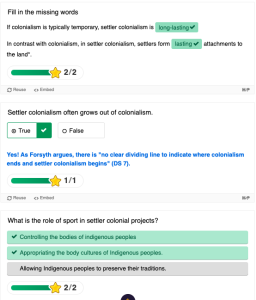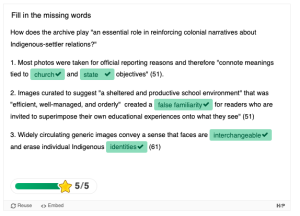4
These are difficult stories. We bear witness in this chapter to the role of sport in furthering the settler colonial projects throughout Turtle Island. Here are some supports to access in the community and from a distance:
First Peoples House of Learning Cultural Support & Counselling
Niijkiwendidaa Anishnaabekwag Services Circle (Counselling & Healing Services for Indigenous Women & their Families) – 1-800-663-2696
Nogojiwanong Friendship Centre (705) 775-0387
Peterborough Community Counselling Resource Centre: (705) 742-4258
Hope for Wellness – Indigenous help line (online chat also available) – 1-855-242-3310
LGBT Youthline: askus@youthline.ca or text (647)694-4275
National Indian Residential School Crisis Line – 1-866-925-4419
Talk4Healing (a culturally-grounded helpline for Indigenous women):1-855-5544-HEAL
Section One: History
A) The Residential School System
Exercise 1: Notebook Prompt
We are asked to honour these stories with open hearts and open minds.
Which part of the chapter stood out to you? What were your feelings as you read it? (50 words)
| What most surprised me within chapter 15 was how sports were used to oppress. I never considered how standardizing a game could be used to enforce assimilation. When reading, I felt disheartened as it just goes to show the lengths people went to cause pain and suffering due to racism. |
B) Keywords
Exercise 2: Notebook Prompt
Briefly define (point form is fine) one of the keywords in the padlet (may be one that you added yourself).

| Cultural assimilation occurs when a minority group enters an area, society, or country with vastly different cultural norms. Because of the majority presence and dominance, the minority group loses all valued behaviours, values, opinions, and other norms. Cultural assimilation can happen fully, where the minority group loses all passed traditions and beliefs, or it can occur partially, where the minority group maintains a few of their traditions. However, overall, cultural assimilation leads to a loss of identity within a culture. Another important note is that cultural assimilation is that it can occur forcefully or by default. An example of forced cultural assimilation is during the Spanish Inquisition where “many Jews were killed upon refusal to convert to Christianity” (Britannica, 2020).
References The Editors of Encyclopaedia Britannica (2020, October 12). Spanish Inquisition Key Facts. Encyclopedia Britannica. https://www.britannica.com/summary/Spanish-Inquisition-Key-Facts
|
C) Settler Colonialism
Exercise 3: Complete the Activities

Exercise 4: Notebook Prompt
Although we have discussed in this module how the colonial project sought to suppress Indigenous cultures, it is important to note that it also appropriates and adapts Indigenous cultures and “body movement practices” (75) as part of a larger endeavour to “make settlers Indigenous” (75).
What does this look like? (write 2 or 3 sentences)
| In practice, colonial projects not only rejected and suppressed the cultures of Indigenous Peoples, but they also worked to put their western spin on what was valued by those who were Indigenous. For example, Indigenous Peoples incorporated “spiritual elements also became incorporated into games…games could also promote community stability” (Press, 2015). Once Canada was introduced to the game, they removed the spiritual element of the sport. They did this by enforcing that “the rules [be] standardized for games such as football, baseball, and hockey, and agreement was being reached on what constituted a standard playing «eld and the length of play” (Press, 2015). The game was no longer about personal development, community, or contain the spiritual element, it was now “making settlers Indigenous” by using their game but colonializing it through the newfound selfish and competitive nature of the standardized sports. This is an example of how settlers were able to take something Indigenous and suppress the history and traditions, removing the Indigenous aspects, and making it their own.
References McGill-Queen’s University Press. (2015). (rep.). Canada’s Residential Schools: The History, Part 1 Origins to 1939 The Final Report of the Truth and Reconciliation Commission of Canada (Vol. 1, pp. 353–374).
|
D) The Colonial Archive
Exercise 5: Complete the Activities
Section Two: Reconciliation
A) Reconciliation?
Exercise 6: Activity and Notebook Prompt
Visit the story called “The Skate” for an in-depth exploration of sport in the residential school system. At the bottom of the page you will see four questions to which you may respond by tweet, facebook message, or email:
How much freedom did you have to play as a child?
What values do we learn from different sports and games?
When residential staff took photos, what impression did they try to create?
Answer one of these questions (drawing on what you have learned in section one of this module or prior reading) and record it in your Notebook.
| As a child, I certainly had a lot of freedom when it came to play. I had the opportunity to play whatever I wanted with whoever I wanted when I was in elementary school at recess. I got to learn and indulge in new games and sports in gym class, without fearing loss or punishment. I was intrigued to hear that “School staff used fear and threats to motivate child athletes” (Skate, 2022). I was motivated as a child to do well for personal growth, and to beat my old records. I consider myself very lucky to have a childhood where I didn’t fear ‘not being good enough.‘ It makes me sad to hear that “if [a student] didn’t win, [they] didn’t get to go on other trips, [and they] didn’t get fed as good” (Skate, 2022). The lives and treatment of Indigenous children is a sad reality that really hits me when I hear about how something as minuscule as a game is turned into an outlet for punishment and racism.
References Skate. The Witness Blanket. (2022). https://witnessblanket.ca/story/skate |
B) Redefining Sport
B) Sport as Medicine
Exercise 7: Notebook Prompt
Make note of the many ways sport is considered medicine by the people interviewed in this video.
| One of the ways sports are considered medicine by those within this video is how sports can help them reconnect with relatives who experienced the pain and suffering from boarding schools. One of the interviewees, Aidan Baker, talks about how the languages and traditions were stripped from his ancestors, but he believes they played Lacrosse as a way to cope, making that sport a medicine to them. According to Chief Robert Joseph, sports were also a way to embrace their traditional languages. He talks fondly about playing sports with his friends, and they would speak in their language to instruct and cheer each other on. Aidan Baker also talks about how his great-grandfather and friends could still speak their own traditional language, leading to a competitive advantage. This gives them a competitive advantage as their opponents could not speak the language, thus, they could not be understood. This is another example of how sport is considered a medicine as it serves to unite. Chief Robert Joseph also talks about this competitive advantage and how “those sporting moments were probably the most happy moments that [they] had in those schools” (Lions, 2022, 6:03), which were a direct result of their traditional language use. William Nahini talks about how he used sports as a therapy at the advice of his elders, as he didn’t want to carry this pain forever. Overall, this video and the interviews reveal sport as a medicine, as put by Chief Robert Joseph, “Sport is essential to progressive wellbeing of Indigenous People” (Lions, 2022, 6:32).
References BC Lions . (2022, September 30). SPORT IS MEDICINE | The importance of sport for Canada’s Indigenous peoples. YouTube. https://www.youtube.com/watch?v=UPAS82U8uwE |
C) Sport For development
Exercise 7: Notebook Prompt
What does Waneek Horn-Miller mean when she says that the government is “trying but still approaching Indigenous sport development in a very colonial way”?
| When Waneek Horn-Miller says the government is “trying but still approaching Indigenous sport development in a very colonial way,” she is referring to the Canadian’s government lack of understanding and attempt to work with Indigenous Peoples. This would allow the government to “understand how [Indigenous] people will come together and develop this” (CBC, 2021, 5:35). Her statement emphasizes that the government is still thinking in a very colonial and settler mindset, rather than stepping into a more productive and inclusive way. Waneek Horn-Miller’s statement implies that the government is not as progressive as it claims to be as they are not taking the proper steps to push sports development for Indigenous Peoples to the next level as they do not consult those who are directly impacted, rather, they use their colonial ideals to achieve ‘progress.’
References CBC News: The National. (2021, July 21). The hurdles Indigenous athletes face chasing Olympic dreams. YouTube. https://www.youtube.com/watch?v=xgoUkepAWPk&t=6s |
Exercise 8: Padlet Prompt
Add an image or brief comment reflecting some of “binding cultural symbols that constitute Canadian hockey discourse in Canada.” Record your responses in your Notebook as well.

| When considering a “cultural symbol” associated with hockey in Canada, I think about the recent victory of Canada against the United States. When playing in the 4 Nations Face-Off championship, Canada beat the United States. This is a prominent symbol as there has been increasing talk about the United States taking over Canada, to make Canada the fifty-first state. This victory against the US showed them Canada is united and strong. It was a political statement in the form of a game, showing that Canada intends to come out victorious and independent, without the aid or assistance of another country. Hockey is also a very popular sport in Canada. If you are Canadian, you have been to a hockey game at least once in your life or know someone who is heavily involved in the game. The fact that Canada won against the US in a hockey game serves as a symbol of who we are and what we stand for, thus, this victory is a prominent “cultural symbol” that is related to hockey within Canada.
References Pereles, Z. (2025, February 21). Canada beats team USA in 4 nations face-off championship thriller; Victor Wembanyama out for season. CBSSports.com. https://www.cbssports.com/nhl/news/canada-beats-team-usa-in-4-nations-face-off-championship-thriller-victor-wembanyama-out-for-season
|
Section Three: Decolonization
Please see the major assignment for this half of the term in the final section of this chapter.


